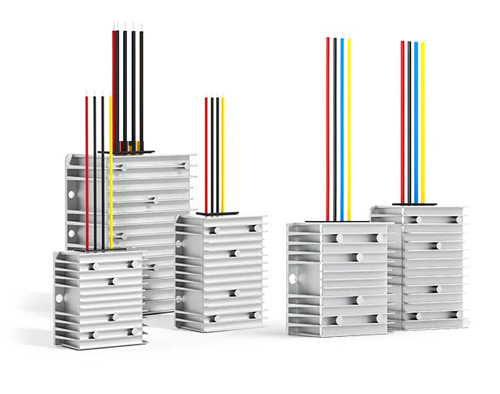5 Mistakes to Avoid When Designing with DC-DC Converters
Designing power systems with DC-DC converters is a foundational skill in modern electronics. Whether you're stepping voltage down with a buck converter, boosting it up with a boost converter, or handling fluctuating inputs using a buck-boost converter, these circuits power everything from smartphones to solar inverters.
However, designing with them isn't just about connecting a few components—it requires understanding system dynamics, thermal behavior, and noise sensitivity. Let's walk through five of the most common and critical mistakes to avoid when working with DC-DC converters and how to mitigate them.

1. Using the Wrong Type of Converter
A DC-DC converter's core function is to match voltages. Selecting the wrong topology for your voltage environment is like trying to paddle a canoe upstream with no paddle.
For example, a buck converter can only step down the input voltage. If your system must run at 5V but the input can fall below 5V, using a buck converter will cause the output to sag or drop out entirely. On the flip side, a boost converter raises voltage but can't lower it. A device needing stable 12V output from a solar panel that fluctuates between 8V and 20V can't be powered reliably by either a buck or boost alone—you'll need a buck-boost converter. This mistake often stems from a lack of clarity around the input power source and its variations. Assuming an input is "usually 24V" without considering brownouts, battery drain, or cold starts can result in a system that fails during real-world conditions.2. Poor PCB Layout Practices
Many designs fail not because the circuit is wrong, but because the PCB layout is wrong. DC-DC converters switch rapidly—often hundreds of kHz or even MHz. At those frequencies, even small PCB traces become inductors and radiators.
Neglecting layout considerations leads to high electromagnetic interference (EMI), voltage spikes, and even oscillations. One common example is routing the power loop (input cap -> switch -> inductor -> output cap) over a large area, increasing parasitic inductance and causing high switching noise.
What's worse is that poor layout can make troubleshooting nearly impossible. Scope probes pick up noise, components behave unpredictably, and problems may come and go depending on how the board is mounted or where the hand is placed.
To avoid it:
- Minimize the loop area between the input capacitor, switching element, and inductor.
- Keep high di/dt loops tight and close to the IC.
- Keep high di/dt loops tight and close to the IC.
- Ensure a solid ground return path, ideally with a continuous ground plane.
- Route analog feedback signals away from high-switching nodes.
3. Neglecting Thermal Considerations
DC-DC converters generate heat—sometimes a lot of it. Many designers make the mistake of focusing solely on electrical parameters and ignoring thermal performance until it's too late.
For example, a converter operating at 95% efficiency still dissipates 5% of the input power as heat. At 20W input, that's 1W of heat. Without proper cooling, that small chip can quickly exceed safe temperatures, especially in compact enclosures or hot environments.
Additionally, component temperatures affect reliability. Every 10°C rise in junction temperature can halve a component's lifespan. And while many converter ICs offer thermal shutdown, relying on this feature isn't good design practice—it's emergency protection, not heat management.
- Calculating power loss using efficiency and load current.
- Ensuring enough copper area under and around the converter IC.
- Using thermal vias to conduct heat to inner or bottom layers.
- Adding heatsinks or forced-air cooling if needed.
- Running thermal simulations or tests early in the design phase.
4. Choosing Inappropriate External Components
Every DC-DC converter depends heavily on external components—especially the inductor, capacitors, and sometimes diodes. Using poor-quality or mismatched components can cause erratic behavior, high output ripple, or even converter failure.
For instance, using a high ESR capacitor can increase output voltage ripple. Choosing an inductor with insufficient saturation current can cause it to overheat and affect efficiency. Selecting a diode with slow reverse recovery in a boost or buck-boost converter topology can lead to shoot-through currents and added EMI.
Component selection is not just about matching nominal values. Designers must also consider ripple current, ESR, temperature coefficients, saturation levels, and transient response.
- Use inductors with current ratings 20–30% above the peak inductor current.
- Choose ceramic capacitors with X7R or X5R dielectrics for stable capacitance.
- For asynchronous converters, use fast recovery Schottky diodes.
- Consult datasheets for recommended values, not just minimums.
5. Skipping Protection and Startup Features
While a converter may function fine in the lab, real-world conditions bring transients, overloads, short circuits, and power sequencing issues. Ignoring startup behavior and fault protection can result in blown fuses or, worse, damaged loads.
For example, a converter without soft-start may draw huge inrush current when enabled, especially if it's charging large output capacitors. Or without UVLO (under-voltage lockout), a converter may try to operate at too low an input voltage, resulting in instability. Similarly, the lack of overcurrent or thermal protection turns small issues into major system failures.
- Choose DC-DC converters with built-in soft-start, UVLO, OCP, and thermal shutdown.
- Add input fusing or TVS diodes to block surges.
- Use sequencing logic when powering multiple voltage rails.
- Implement voltage monitoring for key rails, especially in mission-critical systems.

DC-DC converter design combines electrical theory with real-world pragmatism. Whether you're using a buck converter, boost converter, or buck-boost converter, avoiding these five mistakes ensures a design that's efficient, robust, and reliable.


